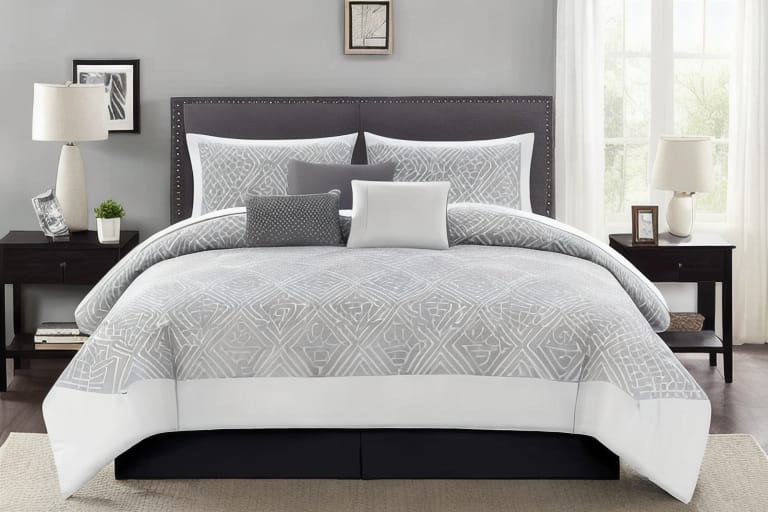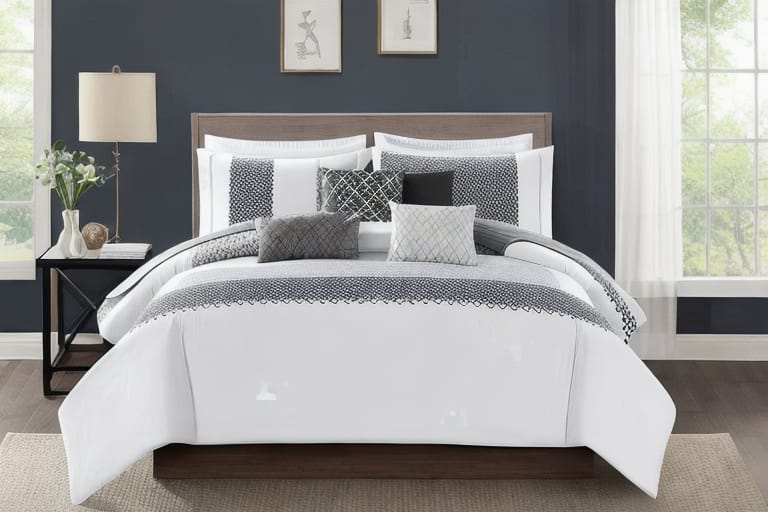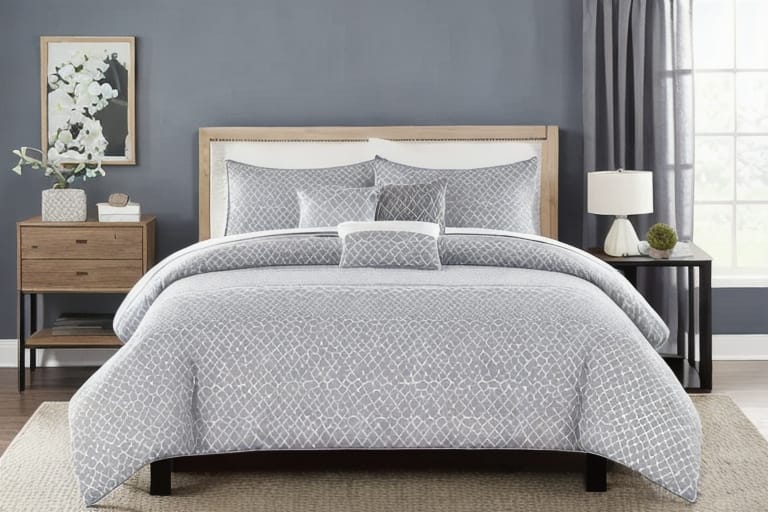Are you looking to add a decadent down comforter to your bedroom for extra warmth and comfort? Getting the right one can be confusing for beginners when faced with so many options. This comprehensive guide breaks down everything you need to know when shopping for the perfect down comforter.
What Is a Down Comforter?
A down comforter is a type of bedding filled with insulation to keep you warm and comfortable at night. Unlike regular blankets or quilts, down comforters are filled with a soft, fluffy down filling that comes from ducks and geese. This premium-fill material provides unmatched warmth and comfort for a luxurious night’s sleep.
Feathers and down make up around 10% of a mature duck’s body weight. While feathers provide structure, down offers superb insulation with a superior warmth-to-weight ratio. Down clusters naturally trap air between tiny fiber pockets, creating loft and efficiently heating the surrounding air.
Downs used in bedding products come from ducks and geese used in the food industry, making it a sustainable byproduct. Responsibly sourced down is also biodegradable and eco-friendly.
Benefits of Down Comforters
There are plenty of types of bedding to choose from, so why opt for a down comforter? Here are the key distinguishing benefits:
- Warmth- Down provides unbeatable lightweight insulation thanks to cluster structure trapping body heat. No other fill comes close to the coziness down supplies.
- Breathability – The fluffy fill also allows excellent airflow so you don’t get hot and start overheating as easily as with other materials. This gives a comfortable night’s sleep.
- Durability – Responsibly-sourced goose or duck down will last over a decade with proper care. This makes it a worthwhile long-term investment for your bedding needs.
- Compressibility – When not in use, quality down comforters easily compress into a small space, making storage convenient until next winter.
- Fluffiness – Properly cared for down recovers well from compression to retain its signature puffy cloud-like texture for years.
In short, down comforters provide luxurious softness, cloud-like loft, and unrivaled warmth – qualities hard to match with alternative fills.
How Down Comforters Are Constructed
From the outer shell fabric to interior baffles and insulation, there are a few key components that make up a down comforter’s construction:
Outer Shell Fabric
The outer fabric casing houses and protects the delicate down inside. Cotton, polyester, or cotton/poly blends make excellent down-proof shell fabrics. High thread counts fabrics like **sateen **or percale feel extra smooth against the skin. Light downproof breathable materials work best to avoid overheating.
Baffles
Down comforters are quilted with inner baffles – fabric pockets that compartmentalize fill and prevent it from shifting around. Baffle box construction features horizontal and vertical seams for maximum insulation stability. Sewn-through comforters only have vertical baffles so the down has more room to spread out evenly.
Fill Material
The key inner component giving unparalleled softness and warmth is the premium goose or duck down. Fill power denotes down quality and loft – higher numbers mean finer, more efficient insulation. Fill weight indicates the density needed for your local climate.
Below 550-600 fill power, lower-grade feather fibers may poke through the fabric. Above 700 fill power, only the most delicate, fluffy, and insulating down clusters remain providing luxurious comfort.
Types of Down Comforters
While a basic down comforter construction remains fairly standard, these bedding staples now come in many shapes and sizes. Popular varieties include:
- Lightweight Summer – Lower fill power around 600 with less density for warm weather use
- All-Season – Approximately 600 fill power and mid-weight fill suitable for most climates
- Ultrawarm Winter – Premium 700+ fill power dense comforter ideal for cold regions
- Oversize – Available in Queen, King, and California King expanded sizes
- Baffle Box – For sleepers wanting maximum warmth with less shifting
- Alternative Down – For ethical vegans or those with severe allergies
Factors To Consider When Buying
Choosing your optimal comforter depends on your climate, sleeping needs, budget, and personal preferences. Key buying considerations include:
Local Weather and Seasons
People in warm, tropical regions need less insulation than those in extremely cold northern winters. Selecting the right fill power and fill weight avoids overheating or chills. Lightweight options work for hotter areas while cold climates demand ultrawarm premium fills.
Sleep Position and Bed Size
Side sleepers benefit from fluffier comforters to fully cover their curled-up shape. Back sleepers appreciate warmth without too much loft pressure. Opt for oversized Queen/King comforters with generous dimensions to prevent the fill from sliding off while you sleep.
Single vs. 2-Person Use
Couples often prefer oversized King/CA King comforters for sharing. Individual personal body heat warms up the open space so dual users may not require as insulating options as single sleepers.
Temperature Regulation
If you run hot or cold while sleeping, open-cell down encourages airflow while retaining heat better than solid or synthetic fibers. This temperature regulation works wonders for those who struggle with maintaining a comfortable body temperature overnight.
Budget
While responsibly sourced down does cost more upfront, it saves money long-term over cheap imitations with shorter lifespans. Any high-quality over 500 fill power will deliver the crucial investment perks of durability, longevity, and performance. Focus less on bargain basement deals under $100 and instead prioritize value for your needs.

Comparison Chart: Down vs Down Alternative Comforters
To highlight key distinctions in performance and quality, here’s a quick comparison chart:
| Factor | Goose or Duck Down | Down Alternative |
|---|---|---|
| Cost | Expensive | Cheaper |
| Durability | Lasts 10+ years | 2-5 years tops |
| Warmth | Exceptional | Decent |
| Weight | Ultralight, portable | Bulkier, heavier |
| Breathability | Excellent | Lacking |
| Allergens? | Can provoke reactions | Hypoallergenic options |
| Eco-friendly | Natural material | Synthetic fibers |
| Compressibility | Highly packable | Loses loft when packed |
| Fluffiness | Regains loft well | Goes flat |
While down alternative comforters mimic attributes of down at a lower price point using polyester fibers or microfiber, they can’t match the cloud-like lightness, warmth, durability and easy care of waterfowl down insulation.
For shoppers with ethical vegan views or allergies/asthma, synthetic or plant-based down alternatives avoid provoking reactions while providing reasonable comfort. But most sleepers appreciate goose or duck-down bedding for unbeatable comfort lasting over a decade.
Outer Shell Fabrics For Down
Alongside your desired fill, also consider which outer shell tickles your fancy:
Cotton
Known for its softness and breathability, woven cotton makes a fine down comforter shell. Helpful for temperature regulation and avoiding night sweats, cotton also holds vibrant dyes well for pretty duvet covers. However, low-cost cottons can pill or bleed color with repeated washing.
Egyptian Cotton
Extra-long fibers like Egyptian cotton weave into softer, stronger, and more durable threads. Resilient Egyptian cotton downproof casings better withstand repeated laundering while retaining supple softness.
Sateen Cotton
Sateen cotton comforters feature a silky-smooth lightweight tightly woven construction. The fine threads and luminous sheen provide a more luxurious look and feel. However, delicate sateen cotton requires gentler care to avoid pilling or snagging.
Percale Cotton
Percale cotton offers a crisp matte finish and cool, crisp handfeel. The tight weave increases durability while retaining breathability. With a lighter feel than sateen, percale makes an excellent year-round cotton shell option suitable for multi-season use.
Fill Power Explained
As mentioned above, fill power denotes the quality and effectiveness of down insulation. This number represents the cubic inches one ounce of down expands to within a testing chamber.
Higher fill powers around 700+ come from smaller, finer plumules that efficiently trap heat in microscopic pockets between feather strands. Below 500 fill power signals lower quality down blended with feather quills that poke through fabric decreasing insulation and comfort.
Ultra-fine 800 fill power hits the high-end benchmark for luxury warmth, lightness, softness and durability in a comforter. But 600-650 fill power still delivers decent performance at an affordable mid-range price point for many shoppers.
Baffle Box vs Sewn-Through Construction
Down comforters come in two main construction styles when it comes to inner compartments:
Baffle Box Construction
**Baffle box construction **features offset vertical and horizontal fabric walls creating inner compartments that limit fill shifting inside your comforter. This provides the most warmth by keeping the down evenly distributed. However, folding flat becomes somewhat more difficult.
Sewn-Through Construction
**Sewn-through comforters **only have simple vertical quilted channels rather than full baffle boxes. While this allows for convenient folding flat, the loose down can more readily clump to one side while sleeping or with regular use over time.
Baffle box styles cost slightly more but deliver better performance, while sewn-through function fine for more casual use.
Caring For Your Down Comforter
Investing in a quality down comforter means taking proper care to enjoy it for over a decade. Here are the top care tips:
- Only wash when truly dirty like any bedding to retain maximum loft
- Dry clean for best results or machine wash cold on the gentle/delicate cycle only
- Reshape and allow to fully dry laying flat before using
- Store off-season in breathable cotton cases to allow vapor transmission
- Avoid compressed vacuum-seal bags damaging inner feather structure over long periods
- Fluff gently by hand regularly to revive thickness; avoid harsh beating
With thoughtful laundering and storage habits, even a budget of around $200 buys excellent mid-tier options providing heavenly rest for years on end.
Matching Your Down Comforter to Bedding
Once you select the perfect down comforter, finish your bedding overhaul by complementing it with matching accessories for a designer look:
Duvet Covers
A removable **duvet cover **lets you change your top comforter’s look anytime while protecting the delicate down insert inside. Like pillow shams slipcover standard bed pillows, and quality duvet covers neatly encase comforters in fresh style. Duvet covers come in materials like cotton, microfiber, and more.
Sheet Sets
Crisp fitted bottom sheets, flat top sheets, and pillowcases contribute to the complete bedding package. Choose breathable cotton or temperature-regulating moisture-wicking performance fabrics to keep you comfy all night long.
Decor Pillows
Add the final crowning accents with decorative backing pillows mixing colors, textures, and patterns. Faux fur, chenille throws, velvet lumbar cushions, and embroidered accent pillows personalized your space. Arrange pillows against the headboard so you can sit comfortably supported reading or watching TV in bed.
With this top-to-bottom designer ensemble from mattresses and mattress toppers beneath to pillow shams, comforters, sheets, and backing cushions on top, transform your bedroom into a luxurious oasis for deep, restorative sleep.

Shopping Checklist For Your Perfect Down Comforter
Keep this checklist handy when evaluating options to find your dream down bedding:
✔️ Fill Material: Goose or duck down over synthetic alternative
✔️ Fill Power: Over 600 for all-season, above 700 for superior warmth
✔️ Construction: Baffle box for maximum loft retention
✔️ Size: Oversize dimensions for your mattress with partner use
✔️ Fabric: Downproof, breathable cotton in desired weave
✔️ Price: Above $200 for better quality with budget cap
✔️ Care: Gentle cycle wash, air/line dry, store properly
✔️ Matching bedding: Complete the look with coordinating sheets, duvet covers, shams
Frequency Asked Questions: Common Down Comforter Questions
How much does a good down comforter cost?
$150 to $300 buys a very nice queen-sized mid-tier down comforter striking the balance between quality materials and affordability. High-end designer down comforters run $400+ but budget under $100 means lower fill power under 500 with disappointing performance.
What is the warmest down comforter for winter?
For glacial regions and chronically cold sleepers, choose an ultrawarm baffle-box comforter with 700+ fill power-dense insulation. Splurge for Hungarian white goose down or hyper-local ethically sourced down tailored for your climate.
How do you wash a down comforter at home?
Machine wash cold on a delicate/gentle cycle only when truly dirty, using mild detergent. Reshape the flat to fully air dry to revitalize the loft before using. Tumble dry low briefly then air out to complete the drying process if desired.
How long does a quality down comforter last?
With conscientious care, storage, and laundering habits not compacting feathers, even mid-price point ethical down comforters will last over a decade keeping you cozy. Responsibly sourced premium down is built to endure providing excellent return on investment.
Can you put a down comforter in a duvet cover?
Yes, they’re made for each other! Always encase your down comforter in a duvet cover rather than placing it directly on top of the bottom sheets. Duvet covers allow easy style switching, provide an extra moisture protection layer, and prevent body oils from degrading delicate down material over time.
The Best Down Comforters of 2023
If selecting your own dream down comforter seems overwhelming with everything to weigh up, we’ve researched 2023’s top-rated options across budgets and preferences to match quality to your sleep needs:
Overall Best Down Comforter
Brooklinen Down Comforter 700 fill power white goose down, baffle box stitching,400 and 700 fill weights available.








